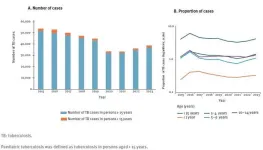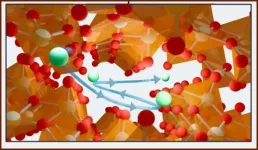(Press-News.org) Scientists at the University of Leicester have captured the first detailed “molecular movie” showing DNA being unzipped at the atomic level – revealing how cells begin the crucial process of copying their genetic material.
The groundbreaking discovery, published in the prestigious journal Nature, could have far-reaching implications, helping us to understand how certain viruses and cancers replicate.
Using cutting edge cryo-electron microscopy, the team of scientists were able to visualise a helicase enzyme (nature’s DNA unzipping machine) in the process of unwinding DNA. DNA helicases are essential during DNA replication because they separate double-stranded DNA into single strands, allowing each strand to be copied.
Dr Taha Shahid, from the University of Leicester’s Institute of Structural and Chemical Biology and lead author on the paper, said: “We recorded multiple snapshots showing how this molecular motor methodically separates the DNA double helix. It’s like a molecular-scale zipper in action and while scientists have long known that cells need to unzip their DNA to copy it, we have never before been able to see exactly how this happens.
“Now we can watch the entire process unfold, in a moment-by-moment fashion, revealing the precise mechanics of one of life's most fundamental processes.”
The researchers found that rather than working by brute force as previously assumed, the helicase operates through an elegant mechanism that uses cellular fuel (ATP) as a precise trigger.
It functions like a six-piston molecular engine - each piston "fires" in sequence, driving the machine forward along the DNA. Crucially, instead of pushing the strands apart directly, it releases built-up tension - like letting go of a compressed spring - allowing the DNA to unwind naturally.
Dr Shahid said: “This "entropy switch" mechanism is fundamentally different from how we thought molecular motors worked. We also solved a long-standing mystery about how cells coordinate DNA copying in both directions, discovering that two helicase machines work together at specific DNA sites, establishing "replication forks" that allow efficient copying of both strands simultaneously.”
The research was an international collaboration between the University of Leicester and the King Abdullah University of Science and Technology (KAUST) in Saudi Arabia, which provided core funding and The Midlands Regional Cryo-EM Facility at the Leicester Institute of Structural and Chemical Biology (LISCB), which provided essential infrastructure for the work.
Dr Shahid continued: “The helicase mechanism we've uncovered appears to be evolutionarily conserved from viruses to humans, providing a universal blueprint for understanding DNA replication across all domains of life. From a medical perspective, many viruses – including poxviruses, papillomaviruses (which can cause certain cancers), and polyomaviruses – rely on similar helicase machinery to replicate. Our detailed structural insights could guide development of precisely targeted antiviral therapies that disrupt viral replication without harming human cells.”
Dr Alfredo De Biasio, senior author on the paper from KAUST and the University of Leicester, added: "This work represents a significant advance in our understanding of the molecular machinery of life. By combining structural biology with sophisticated computational methods, we've been able to reveal not just what this molecular machine looks like, but how it actually works.
“Nature has evolved an incredibly efficient nanoscale machine in the helicase - understanding how it works could inspire the design of synthetic molecular devices that use similar principles for technological applications.”
Professor John Schwabe, Director of Leicester’s Institute for Structural and Chemical Biology, who established the cryo-electron microscopy facility at the University of Leicester, added: “This is another example of how our world-leading facility is contributing to revealing the critical fundamental mechanisms that underpin life.”
END
Breakthrough molecular movie reveals DNA’s unzipping mechanism with implications for viral and cancer treatments
The groundbreaking discovery, published in the prestigious journal Nature, could have far-reaching implications, helping us to understand how certain viruses and cancers replicate.
2025-03-20
ELSE PRESS RELEASES FROM THIS DATE:
New function discovered for protein important in leukemia
2025-03-20
The protein (Exportin-1) is often found in high levels in patients with leukemia, other cancers
Protein was previously known to move materials out of a cell’s nucleus
New findings suggest protein may also stimulate transcription, which if hijacked, could contribute to abnormal cell division (cancer)
Future anti-cancer therapies that target Exportin-1’s role in transcription may be less toxic or more effective than current therapies
EVANSTON, Ill. --- Researchers from Northwestern University have stumbled upon a previously unobserved function of a protein found in the cell nuclei of all flora and fauna. In addition to exporting ...
Tiny component for record-breaking bandwidth
2025-03-20
Plasmonic modulators are tiny components that convert electrical signals into optical signals in order to transport them through optical fibres. A modulator of this kind had never managed to transmit data with a frequency of over a terahertz (over a trillion oscillations per second). Now, researchers from the group led by Jürg Leuthold, Professor of Photonics and Communications at ETH Zurich, have succeeded in doing just that. Previous modulators could only convert frequencies up to 100 or 200 gigahertz ...
In police recruitment efforts, humanizing officers can boost interest
2025-03-20
Many U.S. police departments face a serious recruiting and staffing crisis, which has spurred a re-examination of recruitment methods. In a new study, researchers drew on the field of intergroup communication to analyze how police are portrayed in recruitment materials to determine whether humanizing efforts make a difference. The study found that presenting officers in human terms boosted participants’ interest in policing as a career.
The study was conducted by researchers at the University of California Santa Barbara (UCSB), Texas State University (TXST), ...
Fully AI driven weather prediction system could start revolution in forecasting
2025-03-20
A new AI weather prediction system, Aardvark Weather, can deliver accurate forecasts tens of times faster and using thousands of times less computing power than current AI and physics-based forecasting systems, according to research published today (Thursday 20 March) in Nature.
Aardvark has been developed by researchers from the University of Cambridge supported by the Alan Turing Institute, Microsoft Research and the European Centre for Medium Range Weather Forecasting, providing a blueprint for a completely new approach to weather forecasting with the potential to transform current practices.
The ...
Tuberculosis in children and adolescents: EU/EEA observes a rise in 2023
2025-03-20
As young children have an increased risk of developing tuberculosis (TB) disease during the first year after infection, childhood TB serves as an indicator of ongoing transmission within a community.
In 2023, 1,689 children and young adolescents below the age of 15 years were diagnosed with tuberculosis in the European Union/European Economic Area (EU/EEA) countries. This particular age group usually represents a relatively small proportion among the overall reported TB cases in the region, with a range from 3.4% in 2021 for example to 6.4% in 2016.
However, the data for children and young ...
How family background can help lead to athletic success
2025-03-20
COLUMBUS, Ohio – Americans have long believed that sports are one area in society that offers kids from all backgrounds the chance to succeed to the best of their abilities.
But new research suggests that this belief is largely a myth, and that success in high school and college athletics often is influenced by race and gender, as well as socioeconomic status, including family wealth and education.
“We often think about sports as level playing fields that reward people who earn their success, but that’s not the whole ...
Peatlands' potential to capture carbon upgraded as temperatures rise
2025-03-20
According to a predictive model developed by a CNRS researcher1 and his European colleagues, the microalgae present in peat bogs could offset up to 14% of future CO2 emissions, thanks to their photosynthetic activity2. This conclusion was reached by basing the work on in situ experiments and the various predictive scenarios established by the IPCC. It is the first model to quantify the potential compensation of future CO2 emissions by peatlands on a global scale. This result lifts the veil on a currently ambiguous section of the terrestrial carbon cycle3 and its alterations by anthropogenic climate change. The associated study is published in Nature Climate Change.
Representing ...
New AI tool generates high-quality images faster than state-of-the-art approaches
2025-03-20
CAMBRIDGE, MA – The ability to generate high-quality images quickly is crucial for producing realistic simulated environments that can be used to train self-driving cars to avoid unpredictable hazards, making them safer on real streets.
But the generative AI techniques increasingly being used to produce such images have drawbacks. One popular type of model, called a diffusion model, can create stunningly realistic images but is too slow and computationally intensive for many applications. On the other hand, the autoregressive models that power LLMs like ChatGPT are much faster, but they ...
Xylazine detected in U.S.-Mexico border drug supply, study finds
2025-03-20
Researchers at University of California San Diego School of Medicine, in collaboration with the Prevencasa free clinic in Tijuana, Mexico, have confirmed the presence of xylazine in the illicit drug supply at the U.S.-Mexico border. While xylazine remains less common in the Western U.S., border cities serve as key trafficking hubs and may have higher rates of emerging substances. The findings, published on March 20, 2025 in the Journal of Addiction Medicine, highlight the urgent need for public health intervention.
“Xylazine is a veterinary anesthetic that is not approved for human use and is increasingly detected alongside illicit fentanyl in parts of the United States ...
Producing nuclear fusion fuel is banned in the US for being too toxic, but these researchers found an alternative
2025-03-20
Lithium-6 is essential for producing nuclear fusion fuel, but isolating it from the much more common isotope, lithium-7, usually requires liquid mercury, which is extremely toxic. Now, researchers have developed a mercury-free method to isolate lithium-6 that is as effective as the conventional method. The new method is presented March 20 in the Cell Press journal Chem.
“This is a step towards addressing a major roadblock to nuclear energy,” says chemist and senior author Sarbajit Banerjee of ETH Zürich and Texas A&M University. “Lithium-6 is a critical material for the renaissance of nuclear energy, ...
LAST 30 PRESS RELEASES:
Securing AI systems against growing cybersecurity threats
Longest observation of an active solar region
Why nail-biting, procrastination and other self-sabotaging behaviors are rooted in survival instincts
Regional variations in mechanical properties of porcine leptomeninges
Artificial empathy in therapy and healthcare: advancements in interpersonal interaction technologies
Why some brains switch gears more efficiently than others
UVA’s Jundong Li wins ICDM’S 2025 Tao Li Award for data mining, machine learning
UVA’s low-power, high-performance computer power player Mircea Stan earns National Academy of Inventors fellowship
Not playing by the rules: USU researcher explores filamentous algae dynamics in rivers
Do our body clocks influence our risk of dementia?
Anthropologists offer new evidence of bipedalism in long-debated fossil discovery
Safer receipt paper from wood
Dosage-sensitive genes suggest no whole-genome duplications in ancestral angiosperm
First ancient human herpesvirus genomes document their deep history with humans
Why Some Bacteria Survive Antibiotics and How to Stop Them - New study reveals that bacteria can survive antibiotic treatment through two fundamentally different “shutdown modes”
UCLA study links scar healing to dangerous placenta condition
CHANGE-seq-BE finds off-target changes in the genome from base editors
The Journal of Nuclear Medicine Ahead-of-Print Tip Sheet: January 2, 2026
Delayed or absent first dose of measles, mumps, and rubella vaccination
Trends in US preterm birth rates by household income and race and ethnicity
Study identifies potential biomarker linked to progression and brain inflammation in multiple sclerosis
Many mothers in Norway do not show up for postnatal check-ups
Researchers want to find out why quick clay is so unstable
Superradiant spins show teamwork at the quantum scale
Cleveland Clinic Research links tumor bacteria to immunotherapy resistance in head and neck cancer
First Editorial of 2026: Resisting AI slop
Joint ground- and space-based observations reveal Saturn-mass rogue planet
Inheritable genetic variant offers protection against blood cancer risk and progression
Pigs settled Pacific islands alongside early human voyagers
A Coral reef’s daily pulse reshapes microbes in surrounding waters
[Press-News.org] Breakthrough molecular movie reveals DNA’s unzipping mechanism with implications for viral and cancer treatmentsThe groundbreaking discovery, published in the prestigious journal Nature, could have far-reaching implications, helping us to understand how certain viruses and cancers replicate.




